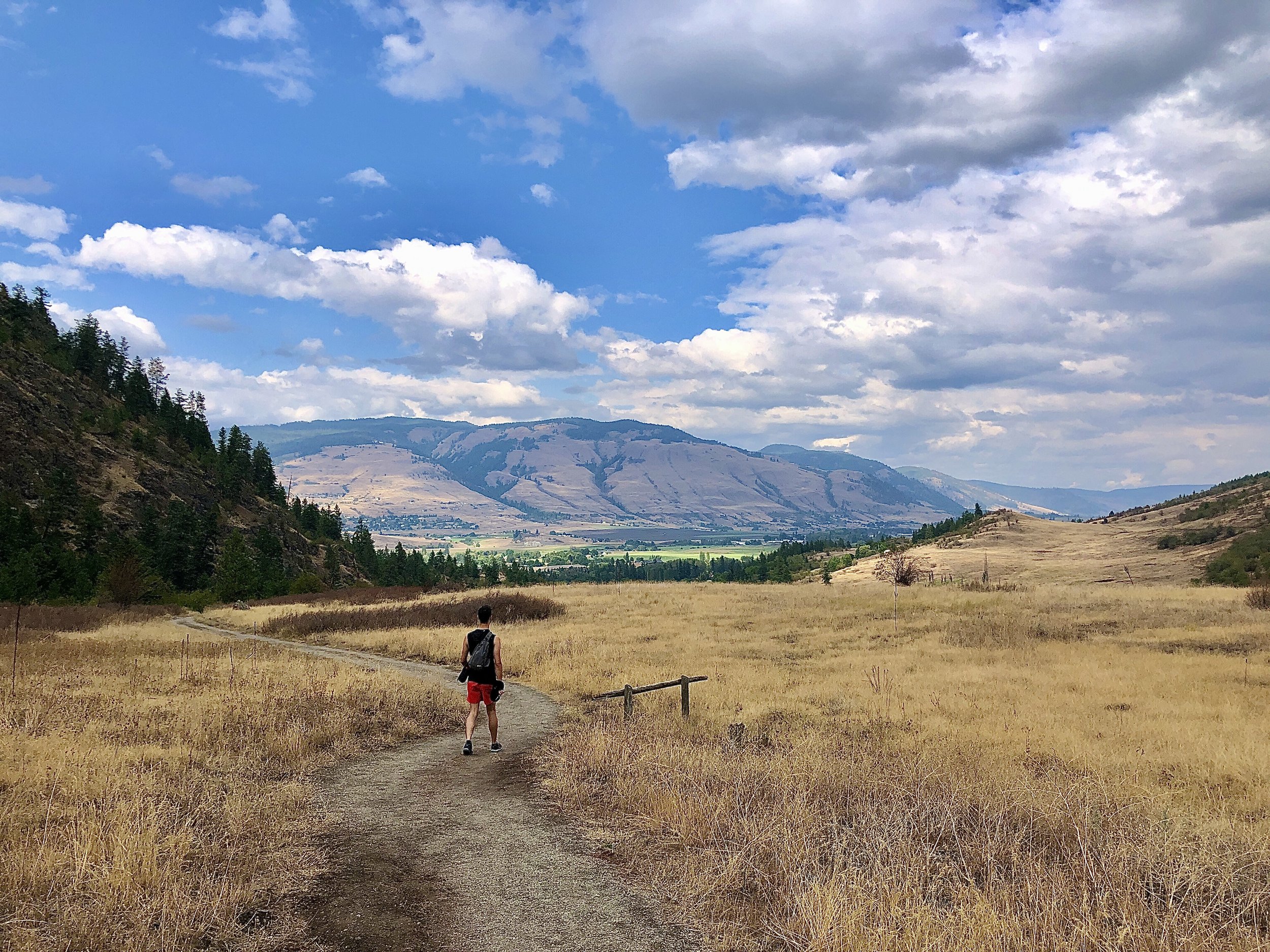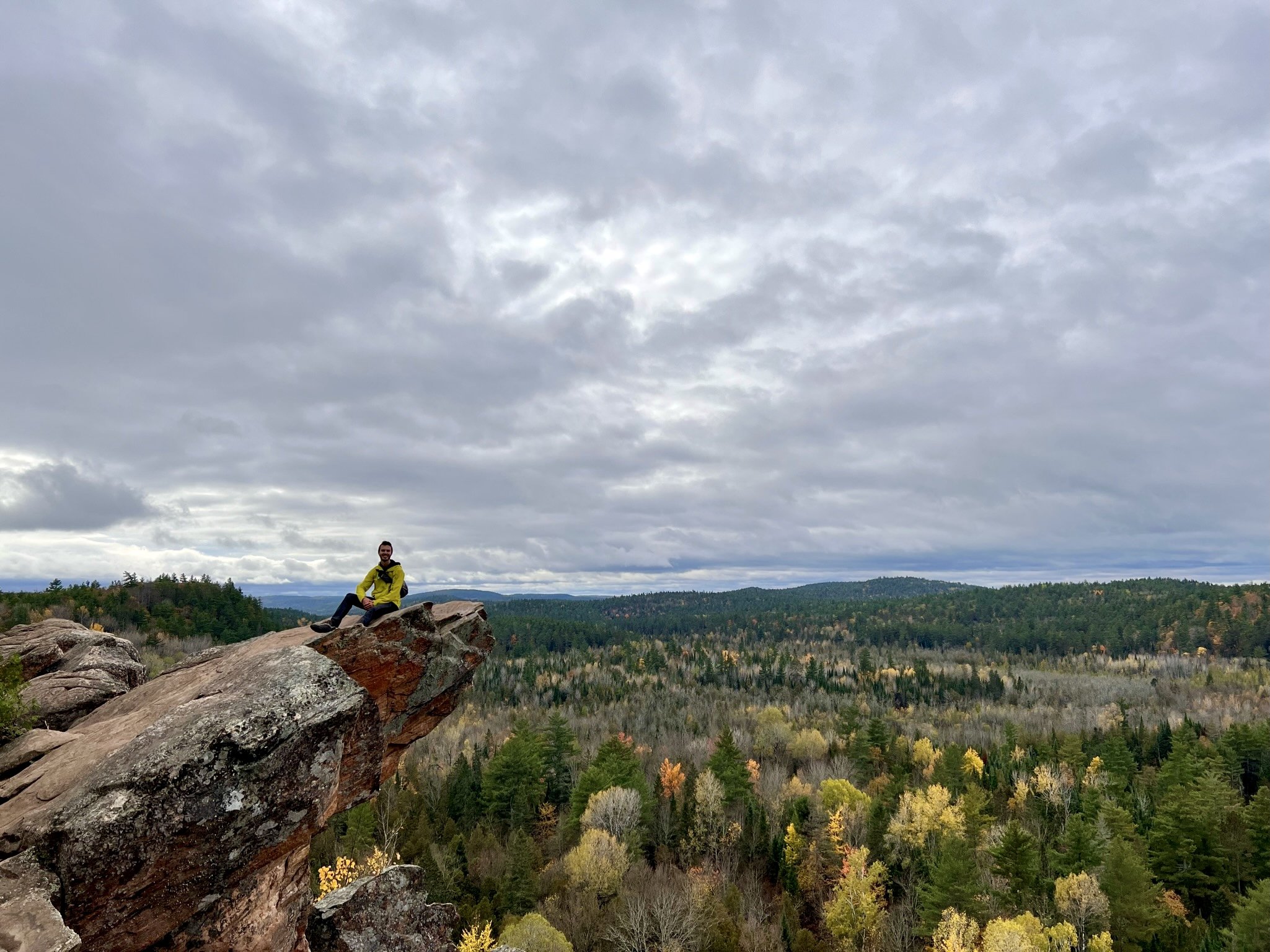This article was originally published on childrenandnature.org.
A serene pit stop. Owen takes in the view of the Myra Canyon Trestles in Kelowna, British Columbia.
In today’s rapidly digitizing world, our youths’ lives are increasingly dominated by screens. As of the time of writing this article, we are observing a concerning upward trend in nearsightedness (myopia) rates,1,2,3 alongside growing awareness that screen time for children under the age of two can result in atypical sensory processing.4 Accompanying increased screen time, recent decades have also seen a trend of children and adolescents spending less time in natural settings and more time indoors.5 This shift has given rise to what author Richard Louv refers to as nature-deficit disorder,6 leading to increases in stress and anxiety, and a diminished sense of environmental stewardship.
Recognizing the urgent need to address these issues, healthcare providers and environmental organizations have come together to promote the healing power of nature. Nature prescriptions (NRx), a practice gaining momentum in healthcare spaces, are backed by a growing body of scientific evidence. As a primary care provider, medical advisor and consultant to various nature-based initiatives, I’ve witnessed how NRx can be a powerful tool in fostering the well-being and development of our youngest generation.
Owen walks through the golden grasslands after enjoying a lengthy hike through Kalamalka Lake Provincial Park.
Teen transformation: A case study of NRx
I first crossed paths with Alex* during the tumultuous years of adolescence, a period marked by profound physical and emotional changes, coupled with the growing weight of societal expectations. When I accepted Alex as a patient, he was struggling with severe anxiety and depression, his life a relentless cycle of therapy sessions and a complex regime of medications. The bustling urban environment in which he resided seemed to amplify his sense of isolation, pushing him further away from his community and, most significantly, from his sense of self. As we chatted, I couldn’t help but notice a subtle shift in his demeanor and body language, especially when I asked about the place where he felt most free—the stream that flowed near his home.
That was my in.
I leveraged resources from organizations like Park Rx America (PRA), NatureQuant and AllTrails to create a care plan for Alex. It started with simple outings to the park and stream near his house. As Alex spent more time outdoors, I saw remarkable changes. His mood improved, his grades improved and he was opening up in our appointments together. Through collaboration with his care team, he was gradually tapered off his antidepressant medication. This outcome was in line with expectations, as studies have shown a correlation between increased exposure to green spaces and a reduced need for antidepressant prescriptions.7 Alex’s progress was becoming a living testament to the clinical benefits of nature prescriptions.
Alex’s journey is one that surely resonates with many of us. In our fast-paced modern lives, we’ve all felt the weight of stress, the pull of societal pressures and the disconnect we can sometimes experience in urban areas. His experience serves as a reminder that amid the hustle and bustle, there’s solace and healing to be found in nature.
A moment of solitude. Owen takes a break on the edge of a cliff at Eagle’s Rest Lookout in Ontario, overlooking the tapestry of autumn colors under a cloudy sky.
How NRx’s work
To craft an NRx care plan, I first have my patients review the NatureScore® of their local area. NatureQuant measures the amount and quality of natural elements in an area, compares them against their potential health benefits, and generates a score that predicts the protective impact of the given natural features on a patient’s health. This neighborhood NatureScore® becomes the benchmark for a patient’s care plan.
Next, patients receive personalized recommendations for nature-based activities that align with their specific health needs. A variety of apps and resources can be leveraged to help identify the perfect natural setting and activity for everyone. For example, AllTrails allows patients to locate suitable outdoor hikes by filtering nearby trails by length, difficulty and proximity. An NRx plan is adaptable to anyone—those with mobility concerns might opt for a paved route that avoids the tripping hazards that may arise on a tree-lined trail. For patients without easy and consistent access to transportation, spending time in nearby nature can prove far more practical and effective than embarking on a lengthier hike outside the city. Other recommendations may include gardening, birdwatching or simply spending unstructured time in a natural setting.
By recommending nature-based activities in natural settings with higher NatureScores® compared to a patient’s benchmark score, I help my patients prioritize spending meaningful time in spaces most beneficial to their health. For instance, if a patient’s NatureScore® in their neighborhood is 22, I might recommend that they spend two hours a week exploring a local park with a NatureScore® of 90 to more fully access the associated health benefits of the natural world.
In this example, the NatureScore® of a property is 52.6 – “Nature Adequate.” To increase access to nature and improve health benefits, a nearby trail with a higher NatureScore® – “Carlington Woods Loop” – is identified on AllTrails.
Dr. Wiseman creates a personalized NRx for his patients, which establishes an outdoor activity plan and identifies nearby opportunities for nature connection.
Organizations like Park Rx America (PRA) in the United States and PaRx in Canada are at the forefront of integrating nature prescriptions into healthcare and community well-being initiatives. PRA has made significant strides by partnering with healthcare providers, public parks and community organizations to facilitate easy access to nature.
Founder of PRA, Dr. Robert Zarr, says, “PRA is uniquely positioned to provide the education and tools to a diverse group of healthcare professionals so that they may readily access our nature prescribing platform. Providers can then seamlessly integrate a nature intervention into their treatment options for individuals at risk of or suffering from a multitude of physical and mental health challenges.”
Similarly, PaRx, launched by the BC Parks Foundation in Canada, has rapidly expanded its reach, becoming the first nationally recognized nature prescription program in the country. Both PRA and PaRx have witnessed a surge of interest, with thousands of providers across North America now registered to create nature prescriptions.
The future of youth well-being
As nature prescriptions gain popularity and recognition, they are becoming an integral part of youth healthcare and education. The holistic approach of integrating nature into the lives of young people holds great promise in addressing not only mental health challenges but also the broader well-being and development of our youth.
In a world where the virtual often overshadows the natural, nature prescriptions serve as a reminder of the profound benefits that the great outdoors can offer to our children. They provide a path towards healthier, happier and more connected youth, grounded in the healing embrace of nature.
*Name has been changed to maintain confidentiality.
References
Landreneau, J. R., Hesemann, N. P., & Cardonell, M. A. (2021). Review on the myopia pandemic: epidemiology, risk factors, and prevention. Missouri Medicine, 118(2)
Foreman, J., et al. (2012). Association between digital smart device use and myopia: a systematic review and meta-analysis. The Lancet Digital Health, 3(12)
Harrington, S. & O’Dwyer, V. (2023). The association between time spent on screens and reading with myopia, premyopia and ocular biometric and anthropometric measures in 6‐to 7‐year‐old schoolchildren in Ireland. Ophthalmic and Physiological Optics, 43(3)
Heffler, K. F., et al. (2024). Early-Life Digital Media Experiences and Development of Atypical Sensory Processing. JAMA pediatrics, 178(3)
Guthold, R., et al. (2020). Global trends in insufficient physical activity among adolescents: a pooled analysis of 298 population-based surveys with 1· 6 million participants. The Lancet Child & Adolescent Health, 4(1)
Louv, R. (2005). Last Child in the Woods (1st ed.). Algonquin Books of Chapel Hill.
Helbich, M., et al. (2018). More green space is related to less antidepressant prescription rates in the Netherlands: A Bayesian geoadditive quantile regression approach. Environmental Research, 166





